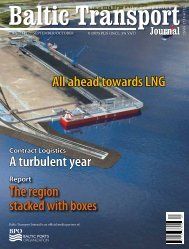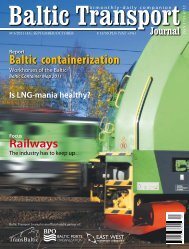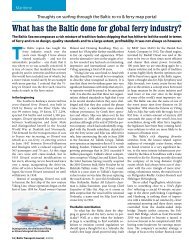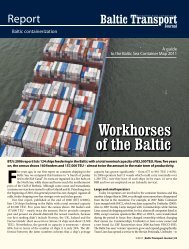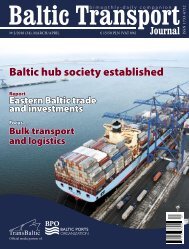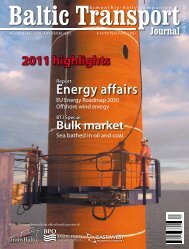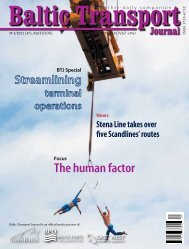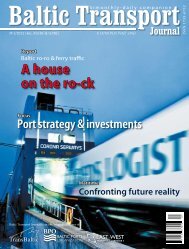You also want an ePaper? Increase the reach of your titles
YUMPU automatically turns print PDFs into web optimized ePapers that Google loves.
opponents came forward. The risk of devastating<br />
flora and fauna in the warm waters of<br />
the Bay of Gdańsk, which would have to be<br />
used to cool turbines has been raised. Poland<br />
is already a European “leader” in carbon dioxide<br />
emission, which exceeds EU standards<br />
many times.<br />
Very green technology<br />
In order to meet the objections at the<br />
next meeting, the originators of the power<br />
plant invited representatives of the General<br />
Electric Energy company. The concern offers<br />
a unique technology of electricity production<br />
called IGCC (Integrated Gasification<br />
Combined Cycle). This technology, as<br />
picturesquely presented by GE Energy, can<br />
be applied even “at the top of a mountain”.<br />
It does not require cooling turbines with<br />
water, as air can be used instead. Due to a<br />
2/3 lesser demand for coolant than in conventional<br />
power plants, fan cooling may be<br />
applied then supported with sprinkling, thus<br />
eliminating the use of the flow system with<br />
water from the bay. The exclusion of chimney<br />
cooling systems makes the pillars that<br />
remove sulphur compounds the only high<br />
objects in the plant, although they are still<br />
lower than in standard solutions. The area<br />
occupied by the IGCC system is compara-<br />
ble to the size of a conventional power plant.<br />
For a power of 800 MW approximately 20<br />
hectares would be sufficient, while doubling<br />
the power does not imply the same increase<br />
in the area. In this context, as guaranteed<br />
by the Port of Gdańsk Authority, the use of<br />
even 40 hectares for the power plant would<br />
not interfere with the development plans of<br />
the Port of Gdańsk.<br />
The input product for the combustion<br />
process is a synthetic gas, relatively simple<br />
to be purified from the remnants of mercury<br />
and sulphur. Arsenic compounds are<br />
removed in a set of precipitators with activated<br />
coal. Therefore, if the IGCC system is<br />
applied in Gdańsk, either fed by gas or coal,<br />
it would mean an actual ecological revolution<br />
because, according to the representatives<br />
of GE Energy, in this solution there are<br />
no solid waste problems. Coal combusted to<br />
produce gas gives waste in the form of slag.<br />
Its chemical indifference, confirmed with<br />
tests, achieves a level that permits waste to<br />
be used to harden the surface of dirt roads<br />
in the forest.<br />
Feasible in 4-5 years<br />
Other investments may follow the construction<br />
of a power plant. The collapse of<br />
the Polish coal export market during the last<br />
two years stopped the transshippment on the<br />
piers of the Northern Port. After the liquidation<br />
of many Polish mines it has become necessary<br />
to start transshipping imported coal<br />
to/from the Port. However, the port appliances<br />
are not adapted to operate in this direction.<br />
Therefore, it might be worth including<br />
the costs of making the coal piers universal<br />
within the comprehensive study on the profitability<br />
of a new power plant location in the<br />
close vicinity.<br />
Today GE Energy declares its readiness to<br />
fulfil the order for a power plant construction<br />
within 4-5 years. The initial calculations show<br />
that this investment is reasonable. The cost of<br />
“constructing 1 MW” in the IGCC technology<br />
is similar to the cost of constructing such<br />
a capacity in a conventional coal combusting<br />
technology. The GE Energy system has already<br />
proven itself in many power plants all over the<br />
world, with 62 coal gasification systems already<br />
operating with this technology.<br />
40% of global electricity production is based<br />
on coal. Refined methods of environmental<br />
protection, such as the IGCC system, can make<br />
such solutions more popular, as coal fields remain<br />
the largest source of fossil fuel today.<br />
Janusz Kasprowicz<br />
Spokesperson for<br />
the Port of Gdańsk Authority SA<br />
3/<strong>2008</strong> | <strong>Baltic</strong> <strong>Transport</strong> <strong>Journal</strong> | 55



